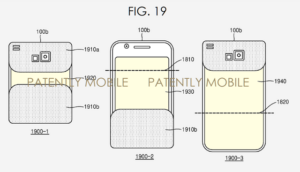Samsung Display has been showing prototype foldable displays for many years – looking at our archives, we saw a very early version at SID 2008 (Display Monitor Vol 15 No 22). In November 2014 (Display Monitor Vol 21 No 47), the company officially presented its first foldable OLED screens to the world at the Samsung Investor Forum*.

We are now almost a year and a half on from the SIF, and there have been no foldable product developments – at least publicly. The closest we have come is the curved AMOLED screen on the Galaxy Edge phones. However, Samsung has been very active in the patent space.
In the last five months, Samsung has filed six new foldable display patents, and been granted one. In November, patents were filed for a ‘scroll-style’ smartphone (granted in January); a ‘tab-style’ smartphone, with part of the screen exposed on one side and which is used like the Edge phones; a foldable phone with a hinge; and a bendable phone. A foldable phone with a projector and a ‘hologram unit’ was described in a new filing in December.
These patents have all had a few things in common: they use flexible displays, and the hardware is the focus. Samsung’s newest patent application changes that up, though.
Filed in January, the patent details a tri-fold foldable device that can run different operating systems, depending on use. Unfolding part of the device might run a smartphone OS; unfolding it a bit more would start a tablet OS; and unfolding it all the way could enable a computer OS.
Source: Patently MobileI can’t be alone in thinking that Windows Continuum sounds perfect for this, can I? The central concept behind that technology is that the same application will run on multiple device form factors, without requiring new coding. Smartphones can run PC, Xbox (now based on a Windows kernel) or tablet apps, or vice versa. The UI would remain similar as the device is unfolded, and apps could scale as needed.
Samsung doesn’t seem to think so – but that might be because this application was first filed in 2014, before Continuum had been announced. The company writes, ‘An application may be executed only in a specific OS. Accordingly, the electronic apparatus needs to drive a plurality of OSs as desired.’ In parts of the document, Samsung makes brief references to ‘Cloud OS 1’ and ‘Cloud OS 2’.
 The tri-fold device could bring together all of the operating systems that Samsung works with today: Android, Tizen and Windows. While Tizen has been even less successful than Windows Phone in smartphones, installing it on a product like this might be Samsung’s best chance to dramatically boost the system’s market share – although if that were the case, would it come at the cost of the user experience?
The tri-fold device could bring together all of the operating systems that Samsung works with today: Android, Tizen and Windows. While Tizen has been even less successful than Windows Phone in smartphones, installing it on a product like this might be Samsung’s best chance to dramatically boost the system’s market share – although if that were the case, would it come at the cost of the user experience?
In 2014, this patent may have seemed like a revolutionary idea. With Windows 10, it looks outdated. That’s not to say that there isn’t merit in the idea of such a flexible (in both senses of the word) device, but it now feels like more of a B2B offering than a B2C one.
Smartphones makers are scrambling to innovate in a mostly-stagnant market (subscription required). LG as much as admitted that the smartphone form factor has been perfected in its MWC launch of the G5 (subscription required) – hence the company’s introduction of companion devices as a differentiator. A foldable phone, though, would be truly different and would certainly result in a cash infusion for whichever vendor has the ability to introduce one first – which, it is looking increasingly likely, will be Samsung. – TA
Analyst Comment
* Samsung Display has been showing these concepts privately for some time, as we mentioned in our CES report. The difficulty is not in making the devices foldable (although there is room to further reduce the bend radius to make devices flatter when they are folded); it is in making them robust enough to survive the handling and mishandling by users, as I understand it. (BR)

